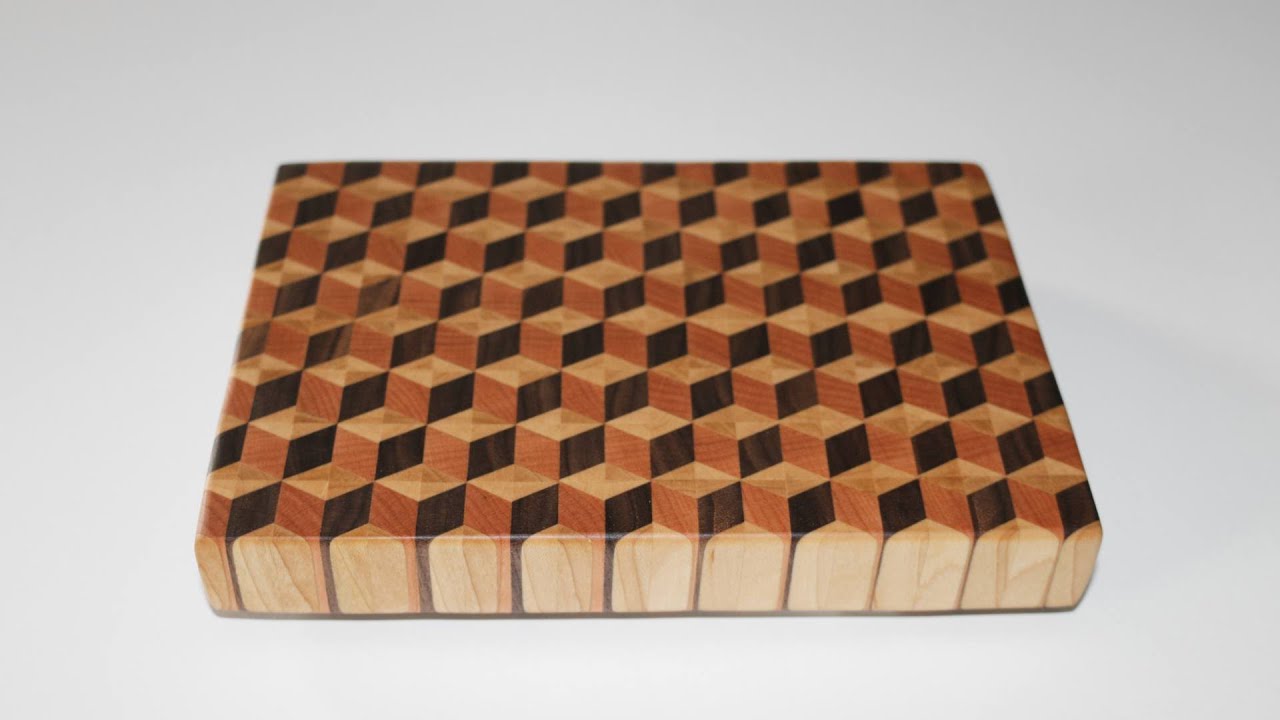This project was built and designed by Caleb from Caleb’s Fine Woodworking. It’s a visually stunning cutting board that blends precision joinery and artistic design using walnut, maple, and cherry hardwoods.
The optical illusion of floating cubes is created by careful grain orientation and meticulous gluing. It’s a rewarding challenge for intermediate to advanced woodworkers looking to elevate their craft.
Watch the full video and subscribe to Caleb’s channel:
Selecting the Materials
Caleb chooses walnut, cherry, and maple for their natural contrast and durability. Each wood type contributes a unique tone, helping the cube pattern stand out once assembled.
The boards are cut to manageable lengths, then prepped by flattening one face and edge on the jointer. This ensures each board is square and ready for precise cutting later.
Milling for Precision
After jointing, the boards are ripped into narrower strips using the table saw. Walnut and cherry are resawn to thinner dimensions, while the maple is cut even thinner to provide finer detail within the cube design.
A drum sander is used to bring all the pieces to a consistent thickness. This step is crucial—any variation will throw off the alignment during the pattern glue-up.
Initial Glue-Up
The first glue-up involves sandwiching the cherry between two strips of maple. This laminated block forms one edge of the eventual cube.
Separately, walnut pieces are also glued up and allowed to dry. Each block is clamped thoroughly and checked for squeeze-out, which Caleb later removes before the next steps.
Creating the 3D Illusion
Once dry, the blocks are jointed again to re-establish flat reference edges. Caleb then cuts the strips at a 60-degree angle using a miter gauge at the table saw. These bevel cuts will form the angled sides of each cube when assembled correctly.
The angled pieces are then cut into shorter segments. These segments are trimmed to remove sharp corners, which helps create the final illusion of three-dimensional cubes once arranged with the end grain facing up.
Pattern Layout and Final Glue-Up
Caleb carefully arranges the segments so that the contrasting woods alternate direction and color. The cube effect comes to life when the grain direction and tones are placed correctly—precision is key here.
The board is glued together in two halves for better control and alignment. After the first glue-up, the two halves are clamped and joined to form the full board, taking extra care to align each row.
Surfacing and Cleanup
Once the glue has dried, the board is sent through the drum sander again to remove glue residue and even out any slight height differences.
Caleb flushes the edges at the table saw to square off the perimeter. He also adds a round-over to the edges using a router to soften the feel and create a more finished appearance.
Hand Sanding and Finishing
Before applying finish, the board is thoroughly hand-sanded to remove sharp edges and refine the surface. Extra attention is given to corners and joints to ensure the pattern remains crisp without any tear-out or blemishes.
Mineral oil is applied as a food-safe finish. The oil enhances the wood tones and reveals the depth of the grain, bringing the cube illusion to life in a dramatic way.
Final Thoughts
This 3D cube end grain cutting board is more than just a kitchen tool—it’s a piece of functional art. Caleb’s step-by-step process shows how careful planning and material selection can result in a stunning and durable project.
The build combines solid woodworking fundamentals with creative design, making it a great project for anyone ready to take on a more complex challenge. Whether it’s for your own kitchen or as a show-stopping gift, the result is sure to turn heads.
Please support Caleb by visiting his website: https://www.calebscustomwoodworks.com/.
